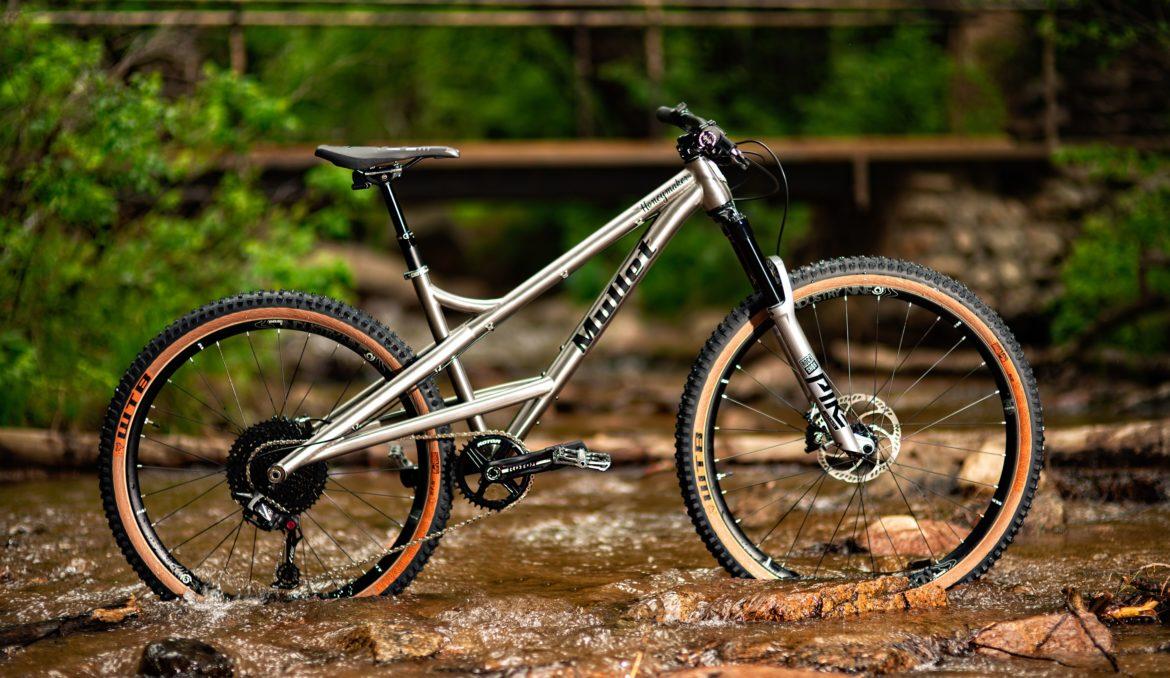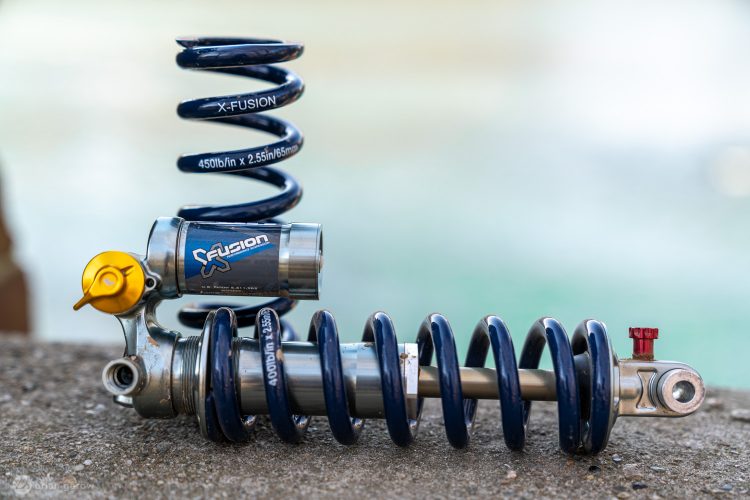
The Canyon Spectral CF 8 K.I.S. ended up on my radar a few months ago and it’s easy to tell why. The Spectral is your average 29er full-suspension mountain bike–150mm of rear travel, available in alloy or carbon and a wide variety of price points. I don’t mean average in an average way, but there is nothing that really makes it pop anymore than any other all-mountain bike on the market.
Key specs
- Suspension travel: 160mm front, 150mm rear
- Geometry: 64° head tube angle, 76° seat tube angle, 437mm chainstay length, 456mm reach (medium)
- Standout features: K.I.S. steering stabilizer, coil shock
- Wheels: Mixed (mullet)
- Weight: About 35lb as tested
- Price: $4,699
The Spectral CF 8 mixed-wheel K.I.S. build however, is anything but average, and it’s easy to tell by the name. The carbon fiber bike still has 150mm of travel with a 160mm fork, but it comes with a coil shock, and a mixed-wheel layout. Also in the namesake, is Canyon’s K.I.S. steering stabilizer. On top of these wild features, the bike comes with a SRAM GX AXS drivetrain, and it sells for under $5,000. Color me interested, in a bike that sounds like a party on two wheels.

About the Canyon Spectral CF 8 K.I.S.
Canyon actually makes this bike in two builds: the CF 8 K.I.S. we tested, and a CLLCTV build with a different parts kit and a lower price tag. We’ll discuss this more later. The Spectral CF 8 largely puts its money into suspension and drivetrain components with the RockShox Lyrik Select+ RC fork, a Super Deluxe Coil Select+RT shock, and a SRAM GX AXS drivetrain.
It finishes off the build with ordinary parts like DT Swiss EX511 370LN wheels, Canyon house brand cockpit components, and SRAM Code R brakes.
Part of the bike’s allure however is the understated and sharp two-toned paint job dividing the bike into two triangles and nearly hiding the rocker link. The Spectral’s stance is a clear signal to mountain bikers that this bike has aggressive geometry.

The size medium I tested has a 64° HTA, a 76° STA, 437mm chainstays, a 1,126mm wheelbase, 456mm of reach.
All of this sells for a reasonable $4,699 on the Canyon website.

On the trail with the Canyon Spectral
I’ve been testing the Spectral CF8 for most of the summer at home in Colorado. Trail conditions have ranged from moist and loamy to dry and dusty, with ever-present rocks.

Climbing
Too many people to count have pointed at the top of the top tube and asked, “What is that?” and guessed either an e-bike motor, trying to push it to turn it on, a wi-fi hot spot, or something else.
It is in fact none of those things and happens to be the hub for K.I.S., Canyon’s steering stabilizer. You can loosen the hex key, and pull it down or push it up and this will either tighten or loosen the springs for a more engaged or disengaged steering stabilization. It’s apparent in a bike stand but rather subtle while the bike is moving.
As I’ve had time with the bike, the biggest rider benefit from K.I.S. in my opinion is on the climbs. K.I.S. helps the handlebars tracking straighter, especially on steep, slower climbs where the bars are more likely to wobble side to side.
The suspension feels about as balanced as the K.I.S. system too. With the coil shock and Canyon’s dialed four-bar layout, the Spectral feels responsive and firm under pedaling power and the coil keeps the rear wheel planted on loose, slippery objects.
One area I did feel that it wasn’t up to par, was negotiating the rear wheel up ledges. The 27.5″ rear wheel couldn’t match the bite of the bigger 29er.
Singletracks contributor Matt Dunn also noted the bike didn’t like the granny gear for technical climbs. This could have put too much torque into the smaller wheel, causing more spin and less bite.
The other area for opportunity here is the bike’s wheelset. I appreciate DT Swiss’s reliability, but the rear hub was about as engaging as a lecture on chlorophyll. I had to think about technical climbs differently knowing there were huge gaps in the 370 hub and that I’d have to pedal fast and hard to make up for them.
Lastly, I had quite a few pedal strikes, seemingly to do with the lower BB height and the 27.5″ rear wheel. Even in the high mode, there were frequent rock strikes.
Overall though, the Spectral CF8 climbed efficiently and it carried its ~35lb weight admirably.
Descending
One of the unexpected things that got me excited to ride this bike downhill is that the Spectral CF 8 is one of the quietest bikes I have ridden in a long time. I’d still trade out the wheels and quiet hubs in a heartbeat for something with better engagement, but cable slap and chain slap were akin to a church mouse.
Taking on long and rocky straightaways in silence became one of my favorite things to do on the Canyon. It has a “behind-the-bike” feel, especially with the lower rear end, and it made me feel confident and fast behind the bigger front wheel.
“The faster you go, the smoother it seems to get,” wrote Matt Dunn.
The coil shock chewed up rocks on long downhills too, even rocks that would have unsettled an air shock a little bit.

The difference between the wheel sizes is noticeable on the descents in a few different ways. Around corners, it encourages a more sweeping turn with the front wheel and slices and cuts with the short rear end. It’s surfy and fun and too easy to replicate. The mullet makes the Spectral ridiculously fun to launch off jumps of any kind too.
Over longer and chunky trails, you can find yourself in trouble with the rear wheel. I burped the rear tire after cornering a little too hard, and the bike experienced punctures on two different occasions.
It’s hard to say if this is solely because the Maxxis Minion DHR II EXO+ lacked sufficient stature to keep it intact or if it was a symptom of the mixed-wheel layout, and the oft-heard statement that the 29er front “writes checks the 27.5 rear wheel can’t cash.”
One of the initial problems with the build is that the bike came with tubes in it. If I owned this bike, I would quickly convert it to tubeless and install a beefier rear tire.
The Spectral’s suspension felt composed in any situation, especially with the coil. The bike soaked up smaller chatter and the mid-stroke was supportive whether coming off of a drop or pushing into a berm.

Canyon Spectral CF 8 K.I.S. component check
There are a lot of interesting choices on this build, especially considering you can get essentially the same bike with the CLLCTV build for $500 less. The CF8 K.I.S. includes an electronic AXS drivetrain over a Shimano XT cable-actuated drivetrain, and the build takes on a RockShox Lyrik Select+ RC fork and SuperDeluxe coil shock over a Fox 36 with a Grip 2 and a Fox DHX Factory coil shock.
This is an easy choice for me. I’d save the $500, and go with the CLLCTV build, and put that savings toward better wheels. The Lyrik feels more supportive than the Fox 36 with Grip 2, but the 36 is supportive enough and I don’t think the GX AXS drivetrain has much of an edge over the 12-speed Shimano. If the K.I.S. build came with Transmission, this would be a different story.

The wheels and cockpit are very underwhelming for this build. I’d love to try the bike with a more responsive rear hub and rims. The dropper post works fine, but it’s nothing to write home about and the alloy 35mm handlebars were stiff and can fatigue your hands on long descents. The SRAM Code R brakes mounted on the bars didn’t give us any issues, but they aren’t the most exciting brakes.
It’s easy to tell where the money went on this build: the carbon frame, suspension, and AXS drivetrain–which are all great, but again, I’d opt for the CLLCTV build because the performance will be just as good and at just above $4,000, it feels like quite a value, whereas our almost $5,000 build isn’t as appealing.
K.I.S.– Simple > Stable
We had mixed feelings about K.I.S. too. I felt that I benefitted more on the climbs from the system and it minimized handlebar wander. On the descents, it was hard for me to discern an actual benefit, as it faded into the background. Ironically, the K.I.S. name coattails on the old adage KISS (Keep it simple, stupid), and makes an association with the K.I.S. system also being simple. It’s not a terribly complicated device, but it can easily turn into work.
K.I.S. is difficult to add tension as you’re actually pulling the plastic piece on the top tube downward against the springs and you’ll need to find a serving of patience if the attachment falls into the top tube and you need to insert the bolt into the threaded attachment. Matt Dunn found that the system can come out of its center setting too by crashing and by turning the bars more than it liked.
Overall, I believe there was a slight net positive with K.I.S. but this wouldn’t be an issue on the CLLCTV build either. You can save the money and any added time fiddling with K.I.S.
Check out Sam’s full review of the Canyon K.I.S. system in case you missed it.

Pros and cons of the Canyon Spectral Mullet CF8 K.I.S.
Pros
- FUN!
- Looks great
- Cornering and handling manners
- Quiet
- Good suspension spec
Cons
- Room for improvement in parts spec, particularly the wheels and cockpit
- K.I.S. is not a clear winner
Bottom line
The Canyon Spectral Mullet CF 8 K.I.S. is a ridiculously fun downhiller with admirable climbing capabilities at a respectable price point.



















